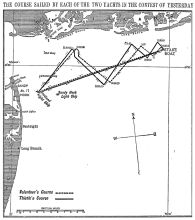 The Talisman hastened down through the mist toward Bay Ridge, where the spectral forms of a fleet of yachts were barely visible through the gloom. The Thistle had remained at the Horseshoe overnight, and so there was no need of tarrying at Tompkinsville to look for her. The Volunteer had already been taken in tow by the good tug B. T. Haviland, and had gone out toward the Scotland Lightship. The Talisman hastened down through the mist toward Bay Ridge, where the spectral forms of a fleet of yachts were barely visible through the gloom. The Thistle had remained at the Horseshoe overnight, and so there was no need of tarrying at Tompkinsville to look for her. The Volunteer had already been taken in tow by the good tug B. T. Haviland, and had gone out toward the Scotland Lightship.
So the Talisman hurried out through the Narrows and eager eyes aboard her peered through the mist and rain in search of the racers. The schooner Clio was met off Hoffman Island, going north under mainsail, foresail, foretopsail, and jib, with a goodly bone in her mouth, showing that there was lung power in the wind. One or two other yachts were met going north, and they, too, were showing speed. The men on their decks were clad from top to toe in oilskins, which glistened with the water that ran down them in streams.
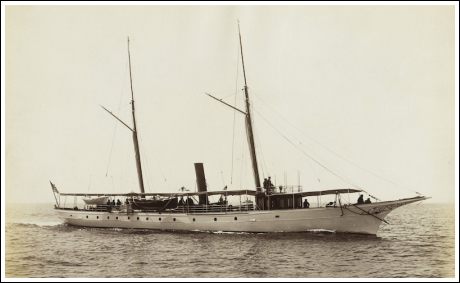
When the Talisman reached the Swash Channel a ghostly mainsail, of huge size, was seen looming up off Sandy Hook. It was lying over toward the west at a fine angle. The observers on the tug scraped the water out of their eyes, rubbed their binoculars dry, and took a squint at the sail. Under it was seen a long black hull, with a keen projection nose. It was the Thistle standing out past the point of the Hook toward the lightship. "She's going very fast," said one. “Do you think she’s going fast enough?" said another.
And then there were silence and laughter, not silence and tears. When the Talisman reached the Scotland Lightship the Electra had come down and taken up her position about a quarter of a mile to the south of it. The Volunteer was bobbing about on the waves and sailing slowly, with her sheets flat aft. The Haviland was near at hand, receiving instructions from the Electra. Presently, at 10:20, a man went aft and heaved the patent log overboard, as the Haviland started a way to measure 20 nautical miles in the teeth of the cool sea wind.

Two little balls were seen to run up the Electra’s signal halyards to the foretopmast head. Then, at 10:21, a gun boomed across the water, and the two little balls burst into fluttering flags. The upper one was a white pennant, with a red ball in it, which, in the international code, stands for the letter C. The lower one was a flag with three perpendicular stripes, red, white, and blue, which is the letter T in the code. The pre-arranged code was hastily consulted by the amateurs on the Talisman, and it was found that C T stood for east by north. That was the direction in which the wind was blowing, and that was to be the course. The Genesta and Galatea both had to begin their outside races by going to leeward, but the Thistle was to have the windward struggle first.
MANŒUVRING FOR POSITION.
The Haviland having got fairly started on her way, the Electra had only to wait for the appointed hour of starting the race. Promptly at 10:30 the preparatory gun was fired. Both yachts were under mainsail, gaff topsail, forestaysail, and jib. The Thistle’s topsail did not sheet out on the gaff as far as the Volunteer’s, nor did it seem to draw quite as well. The Volunteer’s jib set badly at the tack, and the wrinkles there seemed to cause it to shake more than was good for her.

When the preparatory gun was fired the Thistle was just to westward of the Electra and was heading toward her on the starboard tack. The Volunteer was on the port tack to the southward of the cutter. And now began the manœuvring for position at the start. The Thistle run up to the northward of the Electra and wore around. As soon as she got the wind on the port beam she stood over toward the Volunteer. The Volunteer in the meantime had come up into the wind and hove to on the starboard tack. As the Thistle approached her she filled away on the port tack, and, after standing on it a short distance, wore, letting the Thistle cross her bows.
The Thistle came up on the wind as the Volunteer passed her, and getting on the starboard tack stood toward the Electra. The Volunteer jibed, and, getting on the starboard tack, also ran along on the Thistle’s lee. The Thistle kept away and the Volunteer hauled up and went about under the Thistle’s stern. Then the cutter came up on the sloop’s lee bow. Both then rushed toward the Electra on the port tack. Closer and closer they went, each yacht tearing the water into clouds of snowy foam as she heeled over. The Thistle was ahead and was apparently bound now for the line. The Volunteer was following her.
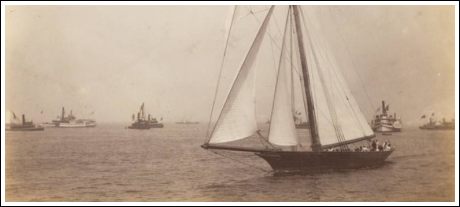
The Thistle's long bowsprit was swiftly approaching the Electra’s stern, and still there was silence aboard the flagship. Was the cutter about to make a miscalculation and reach the line too soon? It looked so. Every one held his breath and counted the seconds. Now the Thistle's bowsprit was right under the Electra’s taffrail. She was too soon. No. she was not.
THE THISTLE STARTING FIRST.
Bang! The Electra‘s gun was fired, and if it had not been shoot to leeward the Thistle would have had her nose almost under it. "Capt. Barr crosses in the smoke of the gun.” said Mr. Bell a day or two ago, and indeed it looked like it. It was a- magnificent start—one yacht crossing at the signal and the other being almost at her heels. Less than half a minute separated them. They crossed thus:
Thistle ...........10:40:21¼
Volunteer ......10:40:50¾

As soon as the Thistle was clear of the Electra’s bow she luffed close around it and flattened her sheets. Her mainsheet was blocked down tight, for they were determined aboard the Thistle to make her point just as high as possible. The Volunteer executed the same manœuvre, but she seemed to be considerably more lively about it, and she gained several valuable yards on the cutter while the latter was doing nothing but pointing, for the Volunteer had filled away again a quarter of a mile before her rival.
The Thistle's headsails shook for some time and it looked as if a desperate effort was being made to jam her up to windward. Both yachts had filled away on the starboard tack, and the trouble was now fairly begun. The excursion boats and the steam yachts got under way and ran down to leeward of the racers, giving them a good wide berth, and showing a disposition to allow them clear and undisturbed water. The Electra set them all a good example by going about a mile and a half away from the race, while the press boat marked the safety limit by keeping half a mile to leeward of the Thistle and a little astern of her.
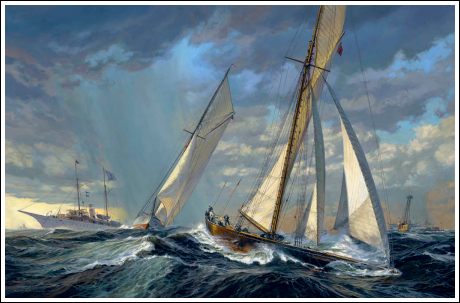
As soon as the yachts had filled away on their first starboard leg, which proved to be a long one, toward Rockaway, the Thistle was beaten. The Volunteer’s centreboard began its work then and there and she began to eat out to windward of the cutter in a manner that must have simply astounded the Scotch gentlemen who came across the Atlantic so full of hope. Perhaps to a landsman’s eye the gain of the Volunteer may not have appeared to be so decided, but to every experienced yachtsman’s eye it was plain that there was no hope for the Thistle after the two racers had gone a mile.
The yachts kept their noses about even, and they were undoubtedly using through the water at nearly the same pace. But the distance between the port rail of the Volunteer and the starboard rail of the Thistle constantly and gradually widened. It looked as if the Volunteer were actually sliding sidewise up to windward. The fact, however, was that the other boat was sliding down to leeward. The Volunteer had crossed the line dead astern of the Thistle, and half a mile from the start she had the weather gauge of her by 50 yards.
“There‘s too much wind and too little sea for the Thistle,", a déclaré un Écossais. Et avec le souffle suivant, il s'est exclamé, “How well that cutter stands up under her canvas!"
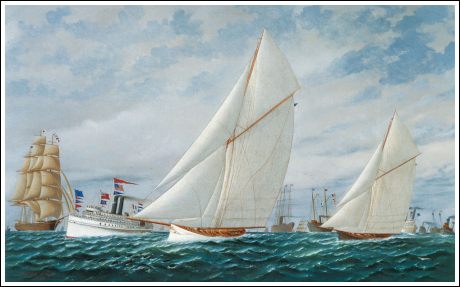
And so she did. She heeled less than the Volunteer, and she also went less. At 10:55 there was a temporary change in the wind, as before slated, and though it threw both boats a trifle off their course it did neither of them any harm. The Thistle‘s sails continued to shake as they had done earlier in the race. The leach of the mainsail flapped all the time. This peculiarity has been noticed before, and it has been said that Capt. Barr rather likes it.
EATING UP TO WINDWARD.
At 11:12 the yachts were about four miles southwest of the big Rockaway Hotel. The Thistle was about 50 yards ahead of the Volunteer, but fully 300 yards to leeward. The two yachts hold their relative positions till 11:32, when the Volunteer luffed and flattened her headsails, which had been shaking. At 11:40 the racers were just off the Rockaway Hotel. The Volunteer was now neck and neck with the Thistle, but still further to windward. The Thistle‘s friends did not at all despair, for they believed that the Volunteer would not gain much more in the windward work, and they trusted to the cutter‘s running power.

Capt. Barr, however, did not like the manner in which the Volunteer was eating up to windward. He evidently came to the conclusion that he could shake off the broad, shallow sloop by going further out to sea, where the two yachts would get a shaking up. Then the deep, heavy hull would tell, and would out through the waves which would stop the light sloop. This is one of the great points made by the advocates of the deep model. If ever they had it rammed down their throats they did yesterday.
At 11:49:40 the Thistle went on the port tack and, of course, the Volunteer instantly slide across her bows a quarter of a mile away. This little bit of show work gave the steamboat fiends an opportunity to turn on their pandemonium and they shrieked and yelped their delight in clouds of steam for fully five minutes. The steamboat fellows are the gallery gods at a yacht race. They don‘t catch the flue points, but they applaud all the spectacular effects.
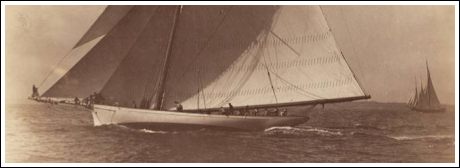
The Volunteer, having run well out on the Thistle's weather bow, went on the port tack at 11:51:30. Now the yachts had the sea ahead and they began that heel-and-toe business which is so dear to the cutter man’s soul. They bobbed up and down in a lively manner, and so did the escort of tugs and steamers, especially the former. Many who had been enjoying the race up to this time were now brought low and men parted with their breakfasts more in sorrow than in anger.
OPENING SCOTTISH EYES.
And now the advocates of cutters in general and the beamy Thistle in particular began to open their eyes; for instead of stopping the Volunteer, the head sea unquestionably stopped her antagonist. On the starboard tack, which the boats stood on for over an hour, the Volunteer had gained only 30 seconds on the Thistle in speed and about a quarter of a mile in pointing; but now she outfooted the cutter in a manner that must have brought dismay to the hearts of the Thistle men. |
|
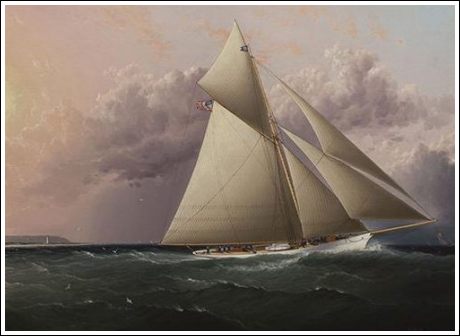
She hounded over the waves as gracefully as a bird over flowers, and with apparently as much case. And to make the thing still more unpleasant the wind dropped. Now, the Thistle had more sea and less wind; but she did worse than before, and her advocates could say nothing except that they could not understand it. The Volunteer was half a mile dead to windward in a very short time after the yachts got on this tack, and the more ambitious tugs, especially one wearing the Thistle‘s colors, showed an inclination to close in on the cutter. Capt. Barr, however, had evidently read the papers after the first race, for he promptly displayed copy of Gen. Paine's sign, reading: “Keep astern.” The tugs, to their credit be it said, at once obeyed, and no warm was done.
The wind had now fallen so light that the sloop Titania, which had been sailing under mainsail, jib and fore staysail, set her gaff topsail and stood almost straight up and down with the additional canvas on. Dark, oily clouds rolled up in the south, and it looked as if a heavy rain were about to set in and kill the wind. Fortunately the rain passed away to leeward of the race, and in a quarter of an hour the wind once more begun to gather power.

The Volunteer hoisted her lead-coated forefoot out of the waves and pushed ahead. The Thistle raised her keen nose in the air and every time it came down she hurled a few bucketful of water out of her channels along her lee deck. At 12:40 the two yachts were still on the same tack and the Volunteer was over a mile dead to windward of her rival. The manner in which she had gained in butting into the seas was simply beautiful. It was not a heavy sea far from it; but there was enough of a bobbery to show which boat was the better for that sort of work.
At 12:48:10 the Volunteer went about on the starboard tack once more and this time the Thistle appeared to be quite ready to go back into smooth water, for she followed her leader at precisely 12:51:15, bring still more than a mile astern. Although the wind had gained in strength after its first drop, it was not so strong now as at the start, and the skippers, having tested the seaway thoroughly, decided that club topsails could be carried advantageously out to the turning point. The Thistle sent her men aloft first, but the Volunteer was the smartest in handling her canvas. At 1:25, when off the Long Beach Hotel, she got her club topsail set while the Thistle did not get hers up till five minutes later.
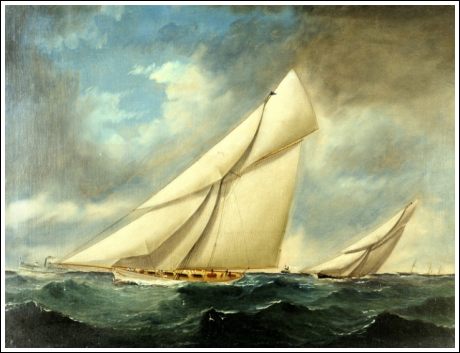
OUTPOINTED AND OUTFO0TED.
After getting her club topsail properly set the Volunteer went on the port tack at 1:37 and the Thistle followed suit at 1:41. To describe their relative positions is simply to repeat an old story. The Volunteer was outpointing the Thistle a great deal and outfooting her fairly. As before noted, the Thistle always lost more on the port tack than she did on the starboard, and this was undoubtedly due to the different approach of the waves.
The yachts were now nearing the outer mark and consequently making shorter tacks. The Haviland was seen looming up ahead with a big New-York Yacht Club flag at her mainmast and a red ball at her foremast. The latter was to signify that she was the mark boat at anchor. The Volunteer went on the starboard tack again at 2 o'clock, and it looked at first as if she was heading directly for the mark. It was evident in a few minutes that she could not fetch it and would have to make another board on the port tack. The Thistle went on the starboard tack at 2:03:57, all of two miles behind.

The wind had again dropped for a moment, but it was only a temporary lull. It freshened soon afterward and then gained in strength steadily during the remainder of the race. The Volunteer went on the port tack for the last time at 2:25:20, and stood for the mark, which she was to leave on the starboard hand. She rounded it amid a storm of whistles and a grand fusillade of guns, which was wafted down to the Thistle as she hammered her way up, and must have sounded saddening to her people. She got on the port tack to stand for the mark at 2:30:45, some time after the Volunteer had rounded. The official time of rounding the mark was as follows:
Volunteer .....2 26 40½
Thistle ….…... 2 41 00
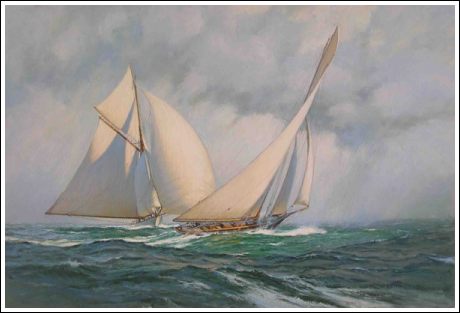
The Volunteer accomplished the beat of 20 miles to windward in 3 hours 45 minutes 49¾ seconds. The Thistle made it in 4 hours and 39 seconds. Thus the Volunteer beat her in the windward work 14 minutes 49¼ seconds.
The yachts started back with a freshening breeze that had good body in it. Their club topsails were already set and they could now get out their other flying kites. The Volunteer, lowered away her spinnaker boom to port and set the huge white sail on it at 2:32:50. The Thistle was smarter in increasing her canvas this time and had her spinnaker set at 2:44:35, just 2 minutes and 20 seconds after rounding, while the Volunteer had been over 6 minutes in doing the same thing.
At 2:36 the Volunteer set her balloon jib topsail, but the Thistle did not spread hers until 3:03. The cutter's did not draw as well as the sloop’s, which set as round and smooth as the skin on a green apple.
THE THISTLE OPPORTUNITY.
Now, however, the Thistle showed that she could go in one direction. She had evidently made up her deep-keel mind to show the Yankees that she could toboggan down the wind about as fast as anything on the earth or the waters under the earth. And the way in which she walked over that 20 nautical miles of water, with her grand white wings spread to the freshening breeze, was a glorious sight to see. Now, indeed, had she not been so hopelessly behind at the outer mark, might the sons of Scotia have pointed to her with pride and exultation. They could be proud of her as it was, for a bonnier boat never came out of the East, and now she was doing her work in noble style.

Occasionally she rolled pretty heavily and threatened to goosewing her spinnaker. Once it went so high that it was on the point of collapsing, but a skillful turn of the tiller set things right again. The press tug Talisman was boiling through the water at a fine gait, and by dint of earnest labor was just about keeping up with Volunteer. Keen eyes were watching the Thistle, and it was evident that she was slowly, but surely, making the outlines of her hull more plain. But the gap was too big to be closed by anything except a fast steam yacht. More than half the steamboats and all of the tugs were unable to gain a yard on the Volunteer on her run in, and the Thistle unquestionably gained on the majority of the steam fleet.
At 4:05 the Volunteer was abreast of the Sandy Hook Lightship. At 4:08 the Thistle, finding the Scotland Lightship a little to windward of the course she was laying, took in her spinnaker and hauled up to weather the leeward end of the finish line. The Volunteer performed the same operation at 4:08:30. The two yachts were now not far from the finish, and were booming along at a splendid pace. The wind was better than ever. The steam yachts and steamboats, with a number of sailing craft, including the schooners Dauntless, Wave Crest, and Rambler, and the sloops Atlantic and Titania, were gathering around the finish to greet the victor. The Electra rushed down to her position south of the lightship and let go her anchor. Along rushed the Volunteer like mist before the wind. Her brown linen balloon jib topsail swelled out till it seemed as if it must burst. She roared through the water.
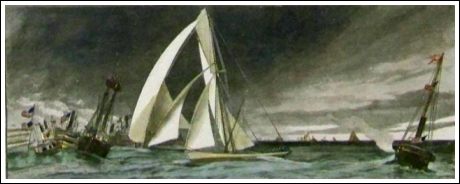
Over the line she sped, with the America’s Cup safe again, and the whistles shrieked and the guns thundered and the people cheered and every one smiled, except the Scotchmen, to whom the tug Charles Runyon set a good example by lowering her Scotch flag to half-mast. The steam yacht Mohican, with Mrs. Bell and the Thistle’s other friends aboard, started for Tompkinsville without waiting for the finish of the cutter.
 That handsome and gallant, though unsuccessful challenger, came tearing down toward the line in a manner that was simply glorious. She did not look like a loser. She had all the dash and spirit of a conqueror, and there wasn’t a man jack of an American who didn’t feel glad and sorry both at once that he had beaten so noble a rival. The race was over. The series was ended, and again the challenger had failed to win even a single race. The ugly old cup, priceless trophy of undimmed nautical glory, was to remain at home, and the marine supremacy of the most unmaritime nation outside of China was once more re-established on a business basis. That handsome and gallant, though unsuccessful challenger, came tearing down toward the line in a manner that was simply glorious. She did not look like a loser. She had all the dash and spirit of a conqueror, and there wasn’t a man jack of an American who didn’t feel glad and sorry both at once that he had beaten so noble a rival. The race was over. The series was ended, and again the challenger had failed to win even a single race. The ugly old cup, priceless trophy of undimmed nautical glory, was to remain at home, and the marine supremacy of the most unmaritime nation outside of China was once more re-established on a business basis.
The Volunteer made the run of 20 miles from the outer mark to the finish in 1:57:06½ and the Thistle in 1:54:12. Thus the latter gained 2 minutes 54½ seconds on the former. On the entire race the Volunteer beat the Thistle 11 minutes 47¾ seconds.
And the following are the official figures:
| |
Start. |
Finish. |
Actual
Times. |
Corrected
Times. |
| |
H. |
M. |
S. |
H. |
M. |
S. |
H. |
M. |
S. |
H. |
M. |
S. |
| Volunteer |
12 |
34 |
58¼ |
5 |
28 |
16¼ |
4 |
53 |
18 |
4 |
53 |
18 |
| Thistle |
12 |
33 |
06 |
5 |
45 |
52¾ |
5 |
12 |
46¾ |
5 |
12 |
41¾ |
The Volunteer was taken in tow by the Haviland and hauled up to Bay Ridge, where she was received with the burning of red fire and the thunder of repeated guns from the fleet and from the Atlantic clubhouse. The Thistle sailed home and went like a deer. She ran across the Volunteers stern, and her company lined along the weather rail and cheered the victor in a most enthusiastic manner. As she passed up the Bay she overhauled the schooner Norseman and the revenue cutter U. S. Grant. Each gave her a gun, and her men responded with cheers. She went flying up to her anchorage at Tompkinsville, where she found the Mohican at anchor waiting for her, as though the proper thing to do on such an occasion was to imitate Gilbert's criminal and “sit in solemn silence” by a “dull, dark dock."

|
 THE THISTLE’S DECISIVE DEFEAT.
THE THISTLE’S DECISIVE DEFEAT.